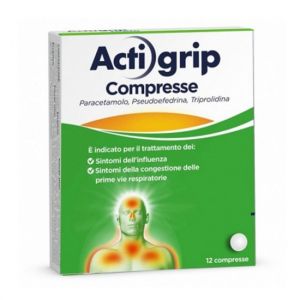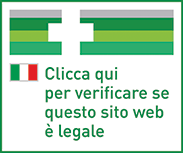Ship in Europe, Find out rates!

Actigrip 12 Tablets
JOHNSON & JOHNSON
NAME
ACTIGRIP 2.5 MG / 60 MG / 500 MG TABLETS
PHARMACOTHERAPEUTIC CATEGORY
Nasal decongestants for systemic use, sympathomimetics.
ACTIVE PRINCIPLES
Each tablet contains: 2.5 mg triprolidine hydrochloride (2.091 mg free base triprolidine); pseudoephedrine hydrochloride 60.0 mg (pseudoephedra na free base 49.154 mg); paracetamol 500.0 mg.
EXCIPIENTS
Each tablet contains: pregelatinised maize starch, povidone, cro spovidone, stearic acid, microcrystalline cellulose, anhydrous colloidal silica, magnesium stearate.
INDICATIONS
Treatment of cold symptoms characterized by nasal obstruction, watery rhinorrhea, headache and / or fever.
CONTRAINDICATIONS / SECONDARY EFFECT
Hypersensitivity 'to the active substances, to other antihistamines or to any of the excipients.
Children under the age of 12.
During pregnancy and breastfeeding.
Patients being treated with monoamine oxidase inhibitors (MAOIs) or in the two weeks following this treatment.
In such cases, the concomitant use of this medicine can cause an increase in blood pressure or hypertensive crisis and in the treatment of lower respiratory tract diseases, including bronchial asthma.
The association with inductive sympathomimetic drugs, alpha sympathetic mimetics (by the oral and / or nasal route).
Due to its anticholinergic effects, do not use in case of glaucoma, prostatic hypertrophy, bladder neck obstruction, pyloric and duodenal stenosis or other tracts of the gastrointestinal and urogenital tracts.
Patients with pre-existing cardiovascular diseases, particularly those with coronary artery disease, hypertension and thyroid disease.
In patients with a history of stroke or who have risk factors for stroke, due to the alpha-sympathomimetic activity of the va socostrictor.
Epilepsy.
Diabetes.
Severe liver and kidney problems.
Paracetamol medicines are contraindicated in patients with manifest insufficiency of glucose-6-phosphate dehydrogenase and in those with severe haemolytic anemia.
Severe hepatocemic insufficiency.
DOSAGE
Dosage
Adults: one tablet 2 - 3 times a day, for a maximum of 5 days of therapy.
Pediatric population (children over 12 years up to 18 years): one tablet 2 - 3 times a day, for a maximum of 3 days of therapy.
Do not exceed the recommended dose; in particular, elderly patients must comply with the minimum dosages indicated above.
Method of administration: take the tablets orally.
The drug should be taken on a full stomach.
STORAGE
Store in a dry place, at a temperature not exceeding 25 degrees C.
WARNINGS
The use of this drug should be avoided if you are already using any other medicine containing paracetamol.
People who offer alcoholism should contact their doctor before taking acetaminophen.
Patients with liver disease should consult their doctor before taking this medicine.
Patients with migraines treated with ergotamine alkaloid vasoconstrictors should consult their physician before taking this drug.
In patients treated with paracetamol, severe skin reactions such as acute generalized exanthematous pustulosis (PEAG), Stevens-Johnson syndrome (SJS) and toxic epidermal necrolysis (TEN) have been reported very rarely.
Patients should be informed of the signs of serious skin reactions and use should be discontinued at the first signs of a rash or any other sign of hypersensitivity.
In the early stages of therapy, patients appear to be at higher risk: the onset of the reaction occurs in most cases in the early stages of treatment.
Serious skin reactions such as acute and generalized exanthematous pustulosis (AGEP) have been reported very rarely with products containing pseudoephedrine.
This acute pustular rash can occur within the first 2 days of treatment, with fever and humerose, small pustules, mostly non-follicular, resulting from a very widespread edematous erythema and localized mainly on the skin folds, trunk and limbs. superior.
Patients should be carefully monitored.
If signs and symptoms such as the formation of numerous small pustules with or without pyrexia or erythema are observed, the administration of this medicinal product should be discontinued.
If the fever persists for more than three days or if symptoms do not improve or appear more within five days or are accompanied by a high fever, rash, excessive mucus and persistent cough, consult your doctor before continuing the treatment. administration.
For the presence of pseudoephedrine, patients should be advised that treatment should be discontinued in case of: hypertension, tachycardia, cardiac palpitations or arrhythmia, nausea or any neurological symptoms (such as the onset or exacerbation of headache).
If sudden abdominal pain, rectal bleeding or other symptoms of ischemic colitis develop, pseudoephedrine should be discontinued and medical attention should be consulted.
The use of antihistamines can mask the first signs of ototoxicity of certain antibiotics.
Patients with respiratory conditions such as emphysema and chronic bronchitis should be advised to consult a physician before using tr iprolidine.
It can cause drowsiness.
Triprolidine can enhance the sedative effects of substances that depress the central nervous system such as alcohol, sedatives, tranquilizers.
Patients should be advised that alcoholic beverages should be avoided during treatment with this drug and that it is advisable to consult their physician before taking this medicinal product concomitantly with central nervous system depraining medications.
Patients with impaired renal function should not take this drug unless advised by the doctor.
Prolonged or high doses of the medicine can cause high-risk hepatitis and even severe changes in the kidney and blood.
In case of renal and hepatocellular insufficiency use only in case of real need and under direct medical control.
During treatment with paracetamol before taking any other drug, check that it does not contain the same active ingredient, as if paracetamol is taken in high doses, serious adverse reactions may occur.
Overdose can lead to hepatic disease.
Careful medical supervision is therefore necessary for both adults and children even if no obvious signs or symptoms appear.
Instruct the patient to contact the physician before combining any other medication.
The use of the medicine is not recommended if the patient is being treated with anti-inflammatory drugs.
Special populations: consult your doctor to determine the dose in the elderly due to their greater sensitivity to the drug.
INTERACTIONS
Anticoagulant drugs (eg.
warfarin).
The concomitant use of paracetamol with oral anticoagulants can lead to slight variations in the INR values.
In this case, patients should seek advice from their doctor or pharmacist before using this drug if they are already taking blood-thinning medications, such as warfarin or other coumarin derivatives.
Monoamine oxidase inhibitors (MAOIs).
Pseud oephedrine exerts its properties as a vasoconstrictor by stimulating adrenergic eceptors and promoting the release of noradrenaline from neuronal sites.
Since MAOIs hinder the metabolism of sympathomimetic amines by increasing the availability of norepinephrine released in the nervous system, they can potentiate the pressure effect of pseudoephedrine.
There have been reports of acute hypertensive seizures due to concomitant use of MAOIs and metic sympathomic amines in the literature.
Substances that depress the CNS (Alcohol, sedatives, tranquilizers).
The drug can interact with alcohol, tricyclic antidepressants, neuroleptics or other drugs with a depressive action on the central nervous system such as barbiturates, sedatives, tranquilizers, hypnotics that must not be taken during therapy.
Associations with indirect sympathomimetics (ephedrine, methylphenidate, phenylephrine) and alpha sympathomimetics for oral and / or nasal route (naphazoline, oxymetazoline, phenylephrine, the trizoline, tramazoline, tuaminoheptane), for the risk of chronic constriction and / or hypertensive crisis.
The concomitant administration of dopaminergic ergot alkaloids (bromocriptine, cabergoline, lys uride, pergolide) and vasoconstricting ergot alkaloids (dihydroergotine, ergotamine, methylergometrine) can induce vasoconstriction and / or hypertensive effects.
Likewise, they should not be taken at the same time as this drug, as it may cause significant interactions, to hypertensives, oral hypoglycemic agents, metoclopramide, other substances with anticholinergic action.
Combinations requiring precautions for use.
Halogenated anesthetic gases: risk of perioperative hypertensive crisis.
It is advisable to stop treatment with this drug a few days before a scheduled surgery.
Fu razolidone causes progressive inhibition of monoamine oxidase, so it should not be taken at the same time as this medicine.
The effect of antihypertensive agents that interfere with sympathetic activity (eg.
methyldopa, alpha and beta-blockers, debrisoquine, guanethidine, beta nidine and bretylium) can be partially canceled by this drug or, therefore, also in this case, should not be taken at the same time.
Habitual ingestion of anticonvulsant drugs or oral contraceptives can, with an enzyme induction mechanism, accelerate the metabolism of paracetamol.
Use with extreme caution and under strict control during chronic treatment with drugs that can determine the induction of hepatic monooxygenases or in case of exposure to substances that can have this effect (for example rifampicin, cimetidine, antiepileptics such as glutethimide, phenobarbital , ca rbamazepine).
The administration of paracetamol can interfere with the determination of uric acid (by the method of phospho tungstic acid) and with that of blood sugar (by the method of glucosiooxidase-peroxidase).
SIDE EFFECTS
Data from clinical trials.
There are insufficient data to report adverse reactions from randomized placebo controlled trials for the combination of parcetamol, pseudoephedrine and tripro lidine.
The following are the adverse reactions reported with a frequency> = 1%, identified in randomized controlled trials with plasma: with formulations containing pseudofedrine as a single active substance: dry mouth, nausea, dizziness, insomnia and nervousness; with formulations containing paracetamol and pseudoephedrine: nervousness.
Incident data from post-marketing experience.
Adverse events identified during post marketing experience with paracetamol, pseudoephedrine, the combination of pseudoephedrine and triprolidine, the combination of pseudoephedrine and paracetamol or the combination of paracetamol, pseudoephedrine and triprolidine are listed below.
Adverse reactions are listed below according to frequency categories using the following convention: Very common (> = 1/10); Com une (> = 1/100, <1/10); Uncommon (> = 1 / 1,000, <1/100); Rare (> = 1 / 10,000, <1 / 1,000); Very rare (<1 / 10,000); Not known (frequency cannot be estimated from the available data).
Psychiatric disorders.
Not known: anxiety, nervousness, restlessness, visual hallucination, insomnia.
Nervous system disorders.
Not known: convulsions, dizziness, excitement, headache (especially in the elderly).
Ca rdiac pathologies.
Not known: palpitations.
Respiratory, thoracic and ediastinal disorders.
Not known: epistaxis.
Skin and subcutaneous tissue disorders.
Not known: pruritus, urticaria, acute generalized exanthematous pustulosis, rash, severe skin reactions including erythema multiforme, stevens johnson syndrome and toxic epidermal necrolysis, photosensitivity.
Renal and urinary disorders.
Not known: dysuria, urinary retention.
Diagnostic tests.
Not known: increased arterial pressure.
Immune system disorders: hypersensitivity reaction, anaphylactic reaction.
Undesirable effects related to the presence of paracetamol: skin and subcutaneous tissue disorders: itchy rash, angioedema.
Systemic disorders and administration site conditions: asthenia.
Blood and lymphatic system disorders: thrombocytopenia, leukopenia, neutropenia, anemia, agranulocytosis.
Hepatobiliary disorders: liver function disorders, hepatitis.
Renal and urinary disorders: renal disorders, acute renal failure, interstitial nephritis, haematuria.
Gastrointestinal disorders: dry mouth, abdominal discomfort, constipation, nausea, vomiting, diarrhea.
Diagnostic tests: increase in transaminases.
Undesirable effects related to the presence of pseudoephedrine.
Psychiatric disorders: hallucinations.
Nervous system disorders: paraesthesia, psychomotor hyperactivity, tremors, cerebrovascular accident.
Cardiac disorders: arrhythmia, tachycardia, myocardial infarction.
Skin and subcutaneous tissue disorders: an gioedema.
General Disorders and Administration Site Conditions: Sweating.
Gastrointestinal disorders: ischemic colitis ca.
Undesirable effects related to the presence of triprolidine.
Psychiatric disorders: euphoria.
Gastrointestinal disorders: dry mouth, abdominal discomfort, constipation, nausea, vomiting, diarrhea.
Nervous system disorders: somnolence.
Cardiac disorders: hypotension (especially in the elderly).
Respiratory, thoracic and mediastinal disorders: hyperv iscosity of bronchial secretions increased.
Eye disorders: acute attack of narrow-angle glaucoma, mydriasis, blurred vision.
In isolated cases, haemorrhagic stroke has occurred in patients who used drugs containing pseudoephedrine.
In particular, these cerebrovascular accidents have occurred during overdose, misuse and / or in patients with vascular risk factors.
Reporting of suspected adverse reactions.
The reporting of suspected adverse reactions that occur after the authorization of the drug is important, as it allows continuous monitoring of the benefit / risk ratio of the drug.
Healthcare professionals are asked to report any suspected adverse reactions via the national reporting system at:
PREGNANCY AND BREASTFEEDING
This drug is contraindicated during pregnancy and breastfeeding.
